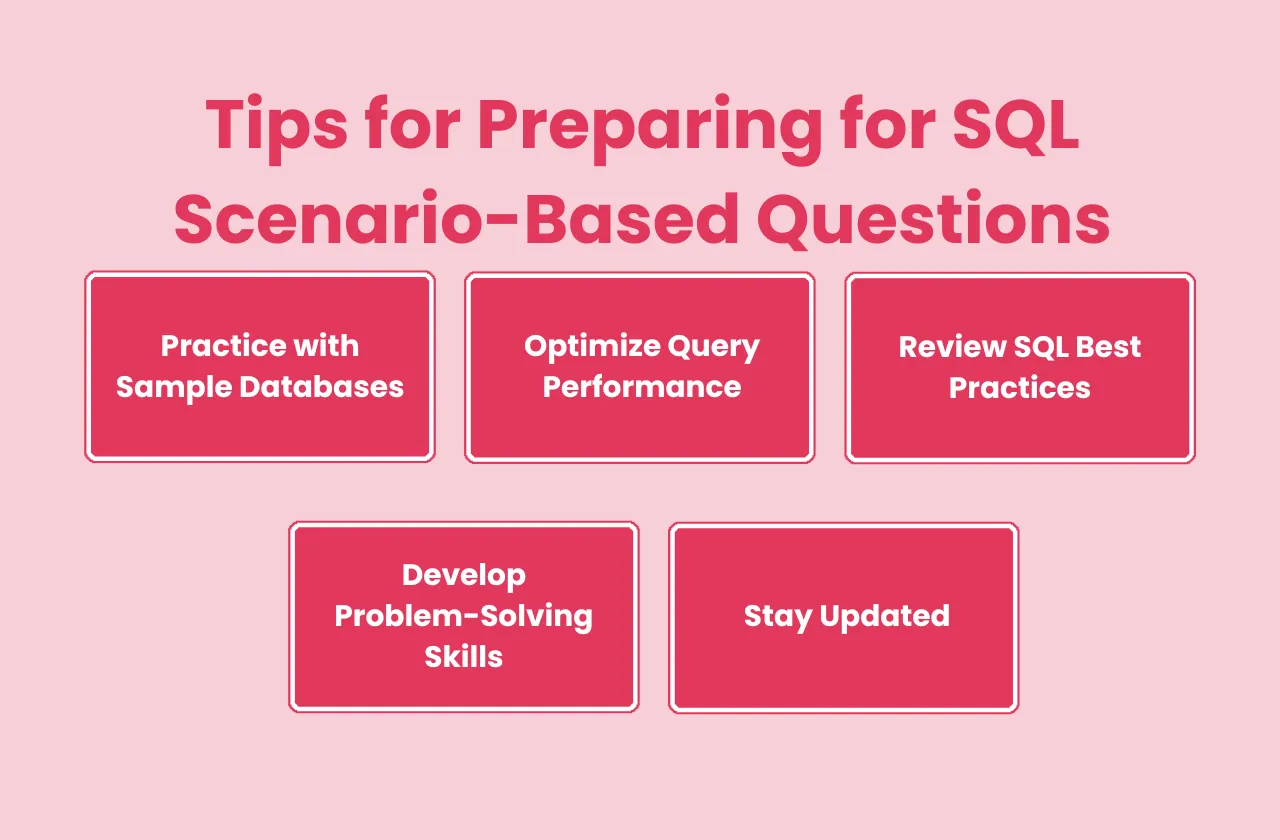The job market for SQL professionals is competitive. Employers need individuals who can not only write basic queries but also apply SQL skills to solve complex, real-world problems. This is where scenario-based interview questions come in. These questions go beyond simple syntax checks and assess your ability to think critically, analyse data, and design efficient solutions. This article serves as your comprehensive guide to understanding, preparing for, and excelling in SQL scenario-based interviews. We’ll cover key SQL concepts, common question types, advanced topics, real-world problem scenarios, and practical tips to help you confidently showcase your SQL expertise.
Key SQL Topics Covered in Scenario-Based Questions
Scenario-based questions are designed to evaluate your practical SQL skills in a context that mirrors real-world situations. These questions typically revolve around the following core areas:

1) Data Querying and Retrieval
This is the foundation of SQL. You need to demonstrate a strong grasp of retrieving and manipulating data from relational databases. This includes:
Filtering data: Mastering the WHERE clause is crucial. You should be comfortable using various operators (=, !=, >, <, LIKE, BETWEEN, IN) and combining conditions using AND, OR, and NOT to extract specific data subsets.
Example: “Retrieve all orders placed by customers in California with a total value greater than $100.”
Aggregating data: You need to be proficient in using aggregate functions like SUM, AVG, COUNT, MAX, and MIN to summarise data.
Example: “Calculate the average salary of employees in the marketing department.”
Joining tables: Understanding different join types (INNER JOIN, LEFT JOIN, RIGHT JOIN, FULL OUTER JOIN) is essential for combining data from multiple tables.
Example: “Retrieve a list of all customers and their orders, including customers who have not placed any orders.”
Using subqueries: Subqueries allow you to write queries within queries, enabling powerful data filtering and transformation.
Example: “Find the names of employees who earn more than the average salary of their department.”
2) Database Optimization and Performance Tuning
Writing efficient SQL queries is critical for any database application. Interviewers will assess your understanding of optimization techniques:
Indexing: Indexes are data structures that speed up data retrieval. You should know how to create and utilise indexes effectively.
Example: “Explain how creating an index on the customer ID column can improve the performance of queries that frequently search by customer ID.”
Query optimization: This involves analysing query execution plans and applying techniques to improve performance.
Example: “A query is taking a long time to execute. Describe the steps you would take to identify the bottleneck and optimise the query.”
Techniques: You might discuss using EXISTS instead of COUNT for checking existence, optimising JOIN order, minimising the use of wildcard characters in LIKE clauses, and rewriting subqueries as joins when possible.
3) Error Handling and Troubleshooting
Real-world data is often messy and unpredictable. You need to demonstrate your ability to handle data anomalies and resolve issues:
NULL values: Understand how to handle missing data using functions like IS NULL, IS NOT NULL, COALESCE, and NVL.
Example: “Write a query to display the customer’s full name, replacing any missing first or last names with ‘N/A’.”
Duplicate data: Identify and manage duplicate records using techniques like grouping and filtering.
Example: “A table contains duplicate customer entries. Write a query to identify and remove these duplicates, retaining only the most recent record for each customer.”
Data anomalies: Recognize and address inconsistencies in data, such as invalid data types or constraint violations.
Example: “A column intended for storing dates contains some values that are not valid dates. Write a query to identify these invalid entries.”
Deadlocks: Understand the concept of deadlocks and how to prevent or resolve them.
Example: “Explain what a deadlock is and describe some strategies to avoid deadlocks in a multi-user environment.”
Let’s delve into some common SQL scenario-based questions to understand how these topics are applied.
Common SQL Scenario-Based Questions
Now, let’s explore some common types of scenario-based questions you might encounter:
Complex Join Scenarios
Scenario: An e-commerce platform stores customer data (customer ID, name, address) in a Customers table and order data (order ID, customer ID, order date, total amount) in an Orders table.
Tasks:
Retrieve all customers who have placed orders in the last month. This requires an INNER JOIN between Customers and Orders with a filter on the order date column.
List all customers and their total order value, including customers who have not placed any orders. This requires a LEFT JOIN from Customers to Orders, with aggregation (SUM) and grouping (GROUP BY) to calculate total order value. Handle NULL values for customers without orders.
Identify orders that do not have a corresponding customer record. This requires a RIGHT JOIN from Orders to Customers, filtering for NULL values in the customer ID column of the Customers table.
Challenges:
- Selecting the appropriate join type based on the desired outcome.
- Optimising join performance, especially with large tables. Consider indexing strategies and query hints.
- Handling NULL values that result from joins.
Aggregation and Grouping Challenges
Scenario: A financial institution stores transaction data (transaction ID, account ID, transaction date, amount) in a Transactions table.
Tasks:
Calculate the total transaction amount for each account. This requires grouping by account ID and using the SUM function.
Find the average transaction amount for each month. This involves extracting the month from the transaction date, grouping by month, and using the AVG function.
Identify accounts with a total transaction amount exceeding $10,000 in the last quarter. This requires filtering transactions within the last quarter, grouping by account ID, summing the amount, and using a HAVING clause to filter accounts with a sum greater than $10,000.
Challenges:
- Using GROUP BY and HAVING clauses effectively.
- Applying window functions for more complex aggregations, such as running totals or moving averages.
- Optimising queries with aggregations. Consider using pre-aggregated tables or materialised views for frequently accessed aggregates.
Advanced Subqueries and Nested Queries
Scenario: A company maintains an employee database with information about employees (employee ID, name, department ID, salary) and departments (department ID, department name).
Tasks:
Find the employees who earn the highest salary in their respective departments. This requires a subquery to determine the maximum salary in each department and then joining it with the employee table to find the employees with matching salaries.
Retrieve the department with the highest average salary. This involves a subquery to calculate the average salary for each department and then another subquery to find the maximum average salary.
List all employees who work in the same department as ‘John Smith’. This requires a subquery to find the department ID of ‘John Smith’ and then using that ID to filter employees.
Challenges:
- Understanding different types of subqueries (correlated, non-correlated).
- Writing nested queries to access data across multiple levels.
- Optimising subqueries to avoid performance issues. Consider rewriting subqueries as joins when possible.
While common SQL questions are important, interviewers may also ask more advanced questions to test your expertise.
Advanced SQL Topics in Scenario-Based Questions
As you progress to more senior-level interviews, you might encounter questions that delve into advanced SQL topics:
Window Functions
Purpose: Window functions perform calculations across a set of rows related to the current row without grouping the rows. This is powerful for analytical tasks.
Common questions:
Rank employees within each department based on their salary. Use the RANK() window function to assign ranks based on salary within each department partition.
Calculate the moving average of sales for the last 3 months. Use the AVG() function with a window frame specification to calculate the average over the preceding 3 months.
Find the top 5 customers by total purchase value for each product category. Use the ROW_NUMBER() function partitioned by product category and ordered by total purchase value to assign ranks and then filter for ranks less than or equal to 5.
Dynamic SQL and Stored Procedures
Scenario: You need to create reusable code modules for common database operations, such as generating reports or performing data updates.
Questions focus on:
Writing stored procedures with input and output parameters.
Example: “Create a stored procedure that takes a customer ID as input and returns the total number of orders placed by that customer.”
Using dynamic SQL to construct queries based on runtime conditions.
Example: “Write a stored procedure that generates a report based on user-selected criteria, such as date range, product category, and region.”
Implementing error handling and transaction control within stored procedures.
Example: “Create a stored procedure to update customer information. Include error handling to ensure data integrity and rollback changes if an error occurs.”
Error Handling in Transactions
Use cases: Transactions ensure data consistency by treating multiple SQL statements as a single unit of work.
Scenario: You need to transfer funds between two bank accounts. This involves debiting one account and crediting another.
Questions might involve:
Using BEGIN TRANSACTION, COMMIT, and ROLLBACK to control transactions.
Example: “Write a SQL script to transfer $100 from account A to account B. Ensure that both the debit and credit operations are executed successfully or the entire transaction is rolled back.”
Implementing TRY-CATCH blocks to handle exceptions within a transaction.
Example: “Modify the fund transfer script to include error handling. If an error occurs during the transfer, log the error message and rollback the transaction.”
Using SAVEPOINT to create intermediate points within a transaction.
Example: “In a complex transaction with multiple steps, demonstrate how to use SAVEPOINT to rollback to a specific point in the transaction if an error occurs.”
To truly prepare for SQL scenario-based interviews, it’s helpful to practise with real-world problem scenarios.
SQL Real-World Problem Scenarios
Interviewers often present real-world scenarios to assess your ability to apply SQL skills in practical situations. These scenarios may involve:
Data Transformation and ETL Processes
Scenario: A company is migrating data from a legacy system to a new database. The data needs to be cleaned, transformed, and loaded into the new system.
Tasks:
Write queries to extract data from the legacy system. This might involve dealing with different data formats, inconsistencies, and missing values.
Cleanse the data by removing duplicates, correcting errors, and standardising formats.
Example: “The legacy system stores phone numbers in various formats. Write a query to standardise all phone numbers to a consistent format.”
Transform the data to match the schema of the new database. This might involve splitting columns, merging columns, or aggregating data.
Load the transformed data into the new database.
Challenges:
- Ensuring data accuracy and completeness throughout the process.
- Optimising queries for efficient processing of large datasets.
- Handling data type conversions and format inconsistencies.
Database Schema Design and Modification
Scenario: You are tasked with designing a database schema for a new application or modifying an existing schema to accommodate new requirements.
Tasks:
Gather requirements and identify entities and relationships.
Design tables with appropriate data types, primary keys, foreign keys, and constraints.
Normalise the schema to reduce data redundancy and improve data integrity.
Example: “Design a database schema for an online store, including tables for customers, products, orders, and order items. Ensure that the schema is normalised to at least third normal form.”
Consider denormalization for performance optimization in specific cases.
Example: “Explain when and why you might choose to denormalize a database schema, and discuss the trade-offs involved.”
Implement the schema using SQL DDL statements.
Challenges:
- Creating a schema that meets the functional and performance requirements of the application.
- Balancing normalisation with performance considerations.
- Understanding the implications of schema changes on existing applications and data.
Handling Security and Access Control
Scenario: You need to implement security measures to protect sensitive data in a database.
Tasks:
Create users and roles with appropriate privileges.
Grant and revoke access to specific database objects (tables, views, stored procedures).
Example: “Create a role called ‘Sales Representative’ and grant them read access to customer data but not to financial information.”
Implement row-level security to restrict access to specific rows based on user roles or criteria.
Example: “Implement row-level security so that sales representatives can only access data for customers in their assigned region.”
Use data masking or encryption to protect sensitive data.
Example: “Implement data masking to hide credit card numbers from users who do not have the necessary permissions.”
Challenges:
- Understanding different security models and access control mechanisms.
- Implementing security policies that meet regulatory requirements and industry best practices.
- Balancing security with usability and performance.
To maximise your preparation, follow these tips for tackling SQL scenario-based questions.
Tips for Preparing for SQL Scenario-Based Questions
To effectively prepare for SQL scenario-based interview questions, consider these tips:

1) Practise with Sample Databases
- Use publicly available databases: AdventureWorks, Chinook, and Northwind are excellent resources for practising SQL queries and scenarios.
- Create your own scenarios: Design your own database schemas and populate them with data. Then, create realistic scenarios and practice writing queries to solve them.
- Use online platforms: LeetCode, HackerRank, and StrataScratch offer SQL practice problems and mock interviews.
2) Optimise Query Performance
- Understand indexing: Learn how indexes work and how to create them effectively.
- Analyse execution plans: Use tools like SQL Server Management Studio or Oracle SQL Developer to analyse query execution plans and identify performance bottlenecks.
- Learn optimization techniques: Familiarise yourself with techniques like using EXISTS instead of COUNT, optimising JOIN order, and rewriting subqueries as joins.
3) Review SQL Best Practices
- Adhere to ANSI SQL standards: While some database systems have specific functions and syntax, strive to use ANSI SQL standards for portability.
- Use clear and concise code: Write queries that are easy to read and understand. Use proper indentation and naming conventions.
- Comment your code: Add comments to explain complex logic or assumptions.
4) Develop Problem-Solving Skills
- Break down problems: Divide complex scenarios into smaller, more manageable steps.
- Think critically: Analyse the problem carefully and consider different approaches.
- Practise your explanations: Be prepared to clearly articulate your thought process and explain your solutions to the interviewer.
5) Stay Updated
- Follow industry blogs and publications: Stay informed about the latest trends and best practices in SQL and database management.
- Learn new features: Explore new features and functionalities in your preferred database system.
By mastering these SQL topics and practising with real-world scenarios, you can confidently tackle SQL scenario-based questions and land your dream job.
Conclusion
SQL scenario-based interview questions are designed to assess your ability to apply SQL knowledge in practical situations. By understanding common question types, practising your skills, and following the tips outlined in this article, you can confidently tackle these challenges and demonstrate your SQL expertise to potential employers. Remember to practise regularly, focus on optimization, and clearly communicate your thought process during the interview. With thorough preparation and a confident approach, you can successfully navigate SQL scenario-based interviews and secure your desired role.
SQL Scenario Based Interview FAQs
1) What are scenario-based interview questions?
Scenario-based interview questions present real-world situations that you might encounter in a job. They assess your problem-solving skills, critical thinking abilities, and capacity to apply your knowledge in a practical context. These questions often require you to analyse a situation, identify key information, and propose a solution using your SQL skills.
2) What is CTE in SQL interview questions?
A Common Table Expression (CTE) is a temporary named result set that you can define within a query. It acts like a virtual table that you can reference within the same query. CTEs are useful for simplifying complex queries, improving readability, and breaking down a problem into smaller, more manageable parts. Interviewers may ask you to use CTEs in your solutions to demonstrate your understanding of this concept.
3) What are good SQL interview questions?
Good SQL interview questions cover a range of topics and difficulty levels. They should assess your understanding of:
- Basic SQL syntax: SELECT, FROM, WHERE, GROUP BY, HAVING, ORDER BY
- Data manipulation: INSERT, UPDATE, DELETE
- Joins: INNER JOIN, LEFT JOIN, RIGHT JOIN, FULL OUTER JOIN
- Subqueries: Correlated and uncorrelated subqueries
- Aggregate functions: SUM, AVG, COUNT, MAX, MIN
- Data types and constraints: Understanding different data types and how to enforce data integrity.
- Indexing and performance tuning: Knowledge of how indexes work and how to optimise queries.
- Error handling and transactions: Ability to handle errors and ensure data consistency.
Good interview questions often involve scenario-based questions that test your ability to apply these concepts in practical situations.
4) How to crack scenario-based interview questions?
To effectively answer scenario-based SQL interview questions:
- Understand the problem: Carefully read and analyse the scenario. Identify the key information, constraints, and the desired outcome.
- Break it down: Divide the problem into smaller, more manageable steps. This helps you organise your thoughts and approach the solution systematically.
- Write a clear solution: Use proper SQL syntax, indentation, and naming conventions to write a clear and concise query.
- Optimise your query: Consider performance implications and use appropriate techniques to improve efficiency, such as indexing and avoiding unnecessary operations.
- Explain your thought process: Clearly articulate your approach to the interviewer. Explain the logic behind your solution and any assumptions you made.
- Test your solution: If possible, test your query on a sample database to ensure it produces the expected results.
Practice, practice, practice: The more you practise with different scenarios, the better prepared you’ll be to handle interview questions.





